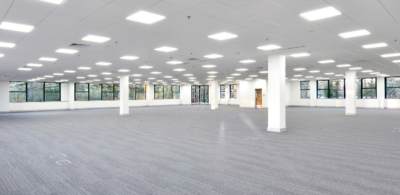As we explore the five key workplace trends in the next five years, my global workplace strategy colleagues and I first examined the importance of making employee experience a core part of business strategy.
Today we’ll turn to a topic that is changing every aspect of our lives: the “Internet of Things” (IoT) or the internet-fueled connectivity that is becoming a seamless part of everyday systems and objects. Translating this into the “Internet of Workplace” will drive the next level of efficiencies, productivity and profits — powered by devices, furniture and environments that interact digitally.
Today, we see IoT integration primarily at the building level, with owners and property managers using technology to gain insight into the ways spaces are used. Many of our clients employ real-time dashboards to track workplace occupancy, water consumption, elevator usage, temperatures and more — and make adjustments in the interest of efficiency.
Dutch bank ABN Amro is bringing the IoT mindset into facilities management. After consolidating many of their employees into their head office, the bank faced new facilities management challenges. They needed solutions to address an environment with more people and more flexible working arrangements and to do that, they needed more data.
As a result, ABN Amro is one of the first companies to establish a dedicated Business Intelligence Facilities Management department. The department is powered by the Position Intelligence Engine (PIE) technology by Lone Rooftop. As Lone Rooftop co-founder Marcel Lamers puts it: “you can basically regard a building as a physical website. How many people are in this building and where? Just like with Google Analytics, you want to monitor movement in order to optimize how the building is used.”
The bank is already seeing results, from using occupancy data to help employees find available workspaces to analyzing traffic patterns around lunchtime to address elevator “rush hours.”
The next step will be translating technology-fueled insights to the personal level in the workplace. We’re starting to see threads of this — from smart phone apps that control the window shades to tablets in meeting rooms that enable employees to adjust temperature settings or order a coffee through a “virtual concierge.” There are even apps through which employees can provide feedback on work areas so that underutilized or unpopular environments can be identified and modified.
But in the coming years, digital integration in the workplace will shift from “nice-to-have” amenities to core functionalities that make the workday more enjoyable and more productive.
Roadmap to 2022: Make the Workplace Reactive and Proactive
From the way we consume media to the way we order food, every aspect of our lives is becoming customizable — a factor that is particularly important to the millennial and Generation Z cohorts. This is one area where it’s imperative to remember that by 2022, Gen Z will be your entry-level employees and millennials will make up a significant portion of your managers and key decision-makers — and their expectations for the workplace will hold even more importance than today.
But the workplace is drastically lagging in terms of opportunities for customization and this must change. People should be able to design their workdays not only in terms of where and when they work but also in terms of the temperature, lighting, arrangement and overall look and feel of their environments. The “workstation” is already highly mobile but this will continue to evolve, which means that many areas throughout the office must become adaptable to different employee preferences.
Beyond reactively adjusting to preferences, the work environment will increasingly be able to recognize people, anticipate their needs and adapt proactively. Imagine: a chair that automatically rises to your preferred seat height. A lighting scheme that prevents the headaches you’re prone to. A program that suggests the best place to work based on your current location and the locations of colleagues you need to collaborate with.
This will have important implications for wellness in the workplace as well. One day, perhaps your work environment will “talk” directly to your fitness wearable and other technologies to adjust workplace settings based on how much sleep you got last night or your current stress level.
One of the new frontiers for workplace technology is facial recognition. The technology is already being used for security and building access, but think about the opportunities for the workplace environment to recognize and respond to employees’ emotional expressions.
Advertisers and retailers are already using technologies like Affdex and Emotient to test emotional reactions to concepts and offerings. What if technology built into a workstation could recognize an employee’s souring mood and generate a pop-up message suggesting a coffee break or a walk around the block — or even automatically adjust the lighting to a calming scheme? The possibilities for emerging digital technologies in the workplace are endless.
Source: “Computers Can’t Read Your Mind Yet, But They’re Getting Closer,” Fortune
Of course, confidentiality, data security and privacy play an important role. Although people share an increasing amount of information through smartphones and social networks these days, there is still a lot of discussion to be had around collecting and sharing data in the workplace. In navigating these nuances, it’s important to focus on using technology in a responsible way to impact employees’ performance and well-being and to openly discuss privacy policies.
Roadmap to 2022: Get Ahead of the Automation Impact
Automation is already changing the nature of the workforce, as many processes shift from human-powered to computerized. But the value of human connection will always be critical to an organization’s ability to compete. As a result, the type of environment employees need will continue to shift toward settings that enable “knowledge work” — fostering innovation, connectivity and creativity.
Think about what this might mean in terms of the technologies you will need to provide to employees. Consider the ways your culture may need to continue to shift in order to create real added value.
One of the best examples of the way the Internet of Things is already transforming the workplace is The Edge building in Amsterdam, primarily occupied by Deloitte. The building has not only been dubbed the “world’s most sustainable office building” but also the “smartest.”
When employees drive into the building, a camera recognizes their license plates, lets them in and directs them to open parking spots. Employees can use an app to locate open workstations based on their schedules and preferences. The app enables employees to adjust lighting and temperature — and even order groceries to be picked up at the end of the day.
Everything from coffee machines to paper towel dispensers are digitally connected, which means that facilities can better manage supplies and refills — pointing to the advantages for employees and building management alike.
Source: “The Smartest Building in the World,” Bloomberg
Source: “The Edge of Tomorrow,” Deloitte
Get Started Now
Consider the role that digital connectivity plays in your workplace or your building. Where can you find opportunities for efficiencies and employee engagement by integrating new, sophisticated technologies?
It’s important to approach technology as a method of boosting your business strategy or even transforming your organization. Consider: What is it you truly want to accomplish and how can technology be an enabler of the necessary change? How can you address important confidentiality and data security needs in implementing systems that respond to and even anticipate employees’ needs?
Don’t miss the opportunity to make your space “smarter” than your competitors’ and create added value for your employees!
This post is part of a series on the five workplace trends that Colliers’ global workplace experts see as the most crucial for companies to align with in the next five years. Stay tuned for upcoming installments and a full white paper coming soon. In the meantime, contact the workplace expert in your region for more insights and information.
Contact
Americas
Keith Perske
Head of Workplace Solutions
Keith.Perske@colliers.com
+1 512 673 3653
Australia & New Zealand
Peter Black
Head of Workplace Solutions
Peter.Black@colliers.com
+61 2 9249 2065
EMEA
JanJaap Boogaard
Head of Workplace Solutions
JanJaap.Boogaard@colliers.com
+31 10 412 00 35
North Asia
Truddy Cheung
Head of Workplace Solutions
Truddy.Cheung@colliers.com
+852 2822 0584
Southeast Asia
Samarth Kasturia
Head of Workplace Solutions
Samarth.Kasturia@colliers.com
+65 6531 8685

 Colliers Insights Team
Colliers Insights Team
 Aaron Jodka
Aaron Jodka
 Amber Merrigan
Amber Merrigan
 Andrew Steele
Andrew Steele